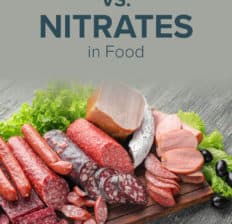This Dr. Axe content is medically reviewed or fact checked to ensure factually accurate information.
With strict editorial sourcing guidelines, we only link to academic research institutions, reputable media sites and, when research is available, medically peer-reviewed studies. Note that the numbers in parentheses (1, 2, etc.) are clickable links to these studies.
The information in our articles is NOT intended to replace a one-on-one relationship with a qualified health care professional and is not intended as medical advice.
This article is based on scientific evidence, written by experts and fact checked by our trained editorial staff. Note that the numbers in parentheses (1, 2, etc.) are clickable links to medically peer-reviewed studies.
Our team includes licensed nutritionists and dietitians, certified health education specialists, as well as certified strength and conditioning specialists, personal trainers and corrective exercise specialists. Our team aims to be not only thorough with its research, but also objective and unbiased.
The information in our articles is NOT intended to replace a one-on-one relationship with a qualified health care professional and is not intended as medical advice.
Are Nitrites Safe? Why They’re Used and Reasons to Avoid Them
April 8, 2023

If you tend to look closely at grocery products while browsing the aisles, especially cured, salted, smoked or lunch meats, you’ve probably noticed the term “nitrites” on the label. Like nitrates, these chemical compounds are commonly used to preserve meats and prevent the growth of bacteria.
While nitrites effectively improve the quality and safety of commonly consumed meat products, excessive exposure does have a handful of health risks, including an increased risk of cardiovascular disease, cancer and type 2 diabetes.
What Are Nitrites?
Nitrites are chemical compounds that contain nitrogen and oxygen, with the chemical formula NO₂. They are commonly used as preservatives in processed meats, such as bacon, ham and hot dogs, to prevent bacterial growth and prolong shelf life.
Nitrites inhibit the growth of bacteria that cause spoilage and foodborne illnesses, such as botulism, and they give cured meats their characteristic pink color and distinctive flavor.
Experimental studies show both benefits and harmful effects of nitrite exposure. While they help prevent foodborne illness, excessive consumption of nitrites has been linked to health risks, such as the formation of carcinogenic compounds in the body and an increased risk of type 2 diabetes.
A major concern with nitrites is that they can react with certain amino acids in the stomach to form nitrosamines, which are known carcinogens. Nitrosamines have been linked to an increased risk of cancer, particularly in the digestive system. Additionally, nitrites can also interact with other substances in the body to form reactive nitrogen species, which can damage cells and contribute to the development of various diseases.
Consuming high levels of nitrites over an extended period of time can also lead to methemoglobinemia, a condition in which the blood is unable to carry oxygen effectively. Symptoms of methemoglobinemia include shortness of breath, fatigue, headache, and blue-colored skin or lips.
Research indicates that methemoglobinemia typically occurs from accidental exposure to excessive amounts of nitrites, but if symptoms are recognized quickly, it can be treated.
Because of these effects of nitrites on the human body, many health experts advise limiting your intake of processed meats and choosing natural alternatives without added nitrites whenever possible.
Nitrite Types
There are several types of nitrites, including the following:
- Sodium nitrite: This is the most commonly used nitrite in food preservation. It is a white to slightly yellowish crystalline powder that is soluble in water and serves as an important nitrite salt in foods and industrial products.
- Potassium nitrite: This is another common nitrite used in food preservation, with a white to slightly yellowish color. It’s also a crystalline powder that’s soluble in water.
- Calcium nitrite: This is a less common nitrite that’s used in food preservation and meat curing. It’s also used as an antifreeze admixture and as a way to prevent corrosion in industrial products.
- Amyl nitrite: This is a medical nitrite used to treat certain heart and blood vessel conditions. It’s classified as an inhalant and works as a depressant that slows down the messages traveling between the brain and body.
- Sodium nitrate: This is not a nitrite but a compound that’s closely related and often used in combination with sodium nitrite in food preservation.
Nitrites vs. Nitrates
Nitrites and nitrates are related chemical compounds that are commonly used in food preservation, and they have similar chemical structures. Nitrites contain one less oxygen atom than nitrates and are converted to nitrates in the body.
Here are some key differences between nitrites and nitrates:
- Chemical structure: Nitrites have the chemical formula NO₂, while nitrates have the chemical formula NO₃. Nitrites contain one less oxygen atom than nitrates.
- Conversion: When nitrates hit the tongue, the bacteria in the mouth or enzymes in the body convert them into nitrites.
- Uses: Nitrites are commonly used as preservatives in processed meats, while nitrates are used in fertilizers for soil. Nitrates are also found naturally in vegetables, fruits and grains. Additionally, the body produces nitrates naturally by excreting the compound in the saliva.
- Health effects: Both nitrites and nitrates have been linked to health risks when consumed in excess. Nitrites have been associated with an increased risk of cancer, while nitrates have been linked to methemoglobinemia, a condition that reduces the ability of blood to carry oxygen.
- Regulations: The use of nitrites and nitrates in food preservation is regulated by many countries to ensure safe levels of consumption. In the U.S., for example, the use of nitrites and nitrates is limited to certain levels and requires labeling on food products.
Foods that Have Them
Nitrites are commonly added to processed meats and meat products to prevent bacterial growth and enhance flavor and color.
Here are some common examples of foods that may contain nitrites:
- Bacon
- Ham
- Hot dogs
- Lunch meat
- Salted and cured meats
- Salami
- Bologna
- Smoked meats
- Sausages
- Jerky
- Corned beef
- Canned meats
- Meat-based baby foods
- Meat-based soups and stews
Keep in mind that not all processed meats contain nitrites, while some natural and organic meat products may also contain nitrites. Read the food labels carefully, and look for one of the nitrite types on the ingredient list.
As a general rule, choose fresh meat products whenever possible to reduce nitrite intake.
Risks and Side Effects
Consuming excessive amounts of nitrites can have various risks and side effects on human health.
Here are some of the risks and side effects associated with nitrite consumption:
- Formation of carcinogenic compounds: Nitrites can react with amino acids in meat products to form nitrosamines, which are known carcinogens that have been linked to an increased risk of cancer, particularly colon cancer.
- Methemoglobinemia: In infants, consuming excessive amounts of nitrites can lead to methemoglobinemia, a life-threatening condition that reduces the ability of blood to carry oxygen. This can cause symptoms such as shortness of breath, bluish skin color and fatigue.
- Headaches and nausea: Some people may experience headaches and nausea after consuming foods containing high amounts of nitrites. There’s research suggesting that migraines are correlated with high levels of nitrites and nitrates in the human oral cavity.
- Increased risk of cardiovascular disease: Some studies indicate that high intake of nitrites may increase the risk of cardiovascular disease by promoting the formation of free radicals and oxidative stress in the body.
- Increased risk of diabetes: Recent research shows that consumption of nitrites and nitrates is associated with type 2 diabetes, as mentioned above.
- Allergic reactions: In rare cases, nitrites can cause allergic reactions in some individuals, such as hives, itching and difficulty breathing.
Choosing natural and minimally processed meat products and limiting intake of processed meats can help reduce nitrite consumption and promote overall health. Eating plenty of organic fruits and vegetables, which contain antioxidants and phytonutrients, will help to reduce damage from oxidative stress and reduce your risk of cancer.
Conclusion
- Nitrites are chemical compounds that contain nitrogen and oxygen. They are commonly used as preservatives in processed meats, such as bacon, ham and hot dogs, to prevent bacterial growth and prolong shelf life.
- Potential dangers of consuming too many nitrites includes increased risk of cancer, cardiovascular disease, type 2 diabetes, headaches, nausea and allergic reactions.
- Limiting your intake of foods containing nitrites, especially salted and cured meats, is recommended to prevent potential nitrite health risks.





